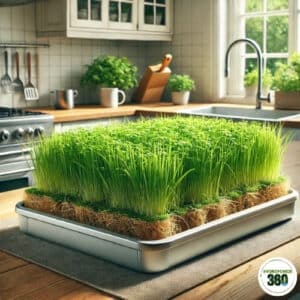Urban Greenery: Hydroponic Grass to Grow Indoors
Table Of Content
For most people, grass feels like the simplest plant on earth. It grows outside, it covers lawns, and animals graze on it naturally. But when you start to look closer, especially from a grower’s point of view, grass isn’t always that easy to manage. Soil conditions, pests, inconsistent weather, and water waste often make traditional grass-growing more complicated than it needs to be. That’s exactly why hydroponic grass is getting so much attention.
Growing grass hydroponically is not just about removing soil — it’s about creating a cleaner, faster, and more efficient way to produce fresh grass year-round. Whether it’s for pet owners, livestock feeding, or simply a beautiful green indoor space, hydroponic grass has quickly become one of the most practical applications of soilless growing.

What Is Hydroponic Grass?
Hydroponic grass refers to any variety of grass that’s grown without soil, using a hydroponic system where water mixed with nutrients feeds the plant roots directly. In many cases, hydroponic grass is grown purely with water, as grass tends to require fewer nutrients than fruit crops or vegetables.
This method allows for faster germination, rapid growth, and a cleaner end product. No mud, no weeds, no pest problems — just fresh, healthy grass ready to use.
Hydroponic grass is commonly grown for animal feed, such as wheatgrass or barley grass for livestock, or for indoor pets like cats and dogs who benefit from fresh greens in their diet. Some people even grow decorative hydroponic grass purely for its aesthetic value indoors.
How Does Hydroponic Grass Growing Work?
The process of growing grass hydroponically is refreshingly simple. Seeds are placed on a grow tray with a moist growing medium or mesh that allows water to reach the seeds while supporting the roots. The tray sits above a nutrient solution or in a system where moisture is supplied regularly through misting or shallow water levels.
The most popular systems for hydroponic grass are extremely low-tech. Often there’s no need for pumps or complex systems. Gravity-fed trays, capillary mats, or basic flood-and-drain setups work perfectly.
Light is important, but hydroponic grass doesn’t need intense lighting conditions to thrive. A bright windowsill or standard LED grow lights are usually more than enough.
The Best Types of Grass to Grow Hydroponically
Not all grass varieties are suited for hydroponic growing, but several types have proven themselves ideal.
Wheatgrass is the undisputed champion of hydroponic grass growing. It germinates fast, grows tall, and delivers excellent nutritional benefits for both humans and animals.
Barley grass is another popular option, especially for animal feed. It grows thick and dense, making it perfect for grazing animals.
Oat grass and ryegrass can also be grown hydroponically, depending on your goals.
Benefits of Growing Grass Hydroponically
The benefits of hydroponic grass are simple but powerful.
First, the speed of growth is remarkable. Hydroponic grass can often be harvested in just 7 to 10 days after germination. Traditional soil-growing rarely matches that consistency.
Second, cleanliness is a huge factor. No dirt means no mess — a big advantage for anyone growing grass indoors or for pets.
Water efficiency is another critical advantage. Hydroponic systems recycle water, using up to 90% less than soil-growing methods.
Additionally, hydroponic grass requires no pesticides or herbicides, making it safer for pets and livestock.
Common Mistakes to Avoid When Growing Hydroponic Grass
Even though growing hydroponic grass is relatively easy, beginners sometimes run into problems.
Overcrowding the seeds is one of the most common mistakes. While it’s tempting to use a thick layer of seeds, overcrowding leads to poor airflow and increased risk of mold.
Inconsistent watering is another issue. The growing medium should stay moist but never waterlogged.
Poor drainage or stagnant water creates bad odors and root rot, even for grass. It’s essential to maintain a clean environment and refresh water regularly.
Maintaining Hydroponic Grass Systems
One of the great things about hydroponic grass is its low maintenance. However, some simple habits ensure the best results.
Regular cleaning of trays between harvests prevents mold buildup. Rinsing seeds before planting removes dust and potential contaminants.
Monitoring light exposure keeps the grass growing upright and evenly. Too little light can lead to thin, weak blades.
Air circulation is helpful, especially in humid environments. A small fan can go a long way in preventing mold.
Who Should Grow Hydroponic Grass?
Hydroponic grass is for anyone who wants fast, clean, and healthy growth without the hassle of traditional soil gardening. It’s especially popular among:
- Pet owners looking for fresh grass for cats, dogs, or small animals
- Livestock farmers seeking fresh, nutrient-rich feed
- Health-conscious individuals growing wheatgrass for juicing
- Indoor gardeners adding green decor without soil mess
Growing Simpler Than Ever
At the heart of hydroponic growing is one simple idea — giving plants exactly what they need, nothing more, nothing less. Grass might be one of the most basic plants, but growing it hydroponically unlocks a level of cleanliness, speed, and efficiency that traditional methods just can’t match.
Whether you’re a beginner looking for a low-maintenance way to explore hydroponics or an experienced grower seeking sustainable animal feed solutions, hydroponic grass is an easy win.
FAQs
How long does hydroponic grass take to grow?
Most hydroponic grass, like wheatgrass or barley grass, can be harvested within 7 to 10 days after germination.
What is the best system for growing hydroponic grass?
Simple tray systems, capillary mats, or shallow water systems work perfectly. No complex pumps or timers are usually required.
Does hydroponic grass need nutrients?
Wheatgrass and similar types often grow well with just water, but adding a mild nutrient solution can support stronger growth.
Is hydroponic grass safe for pets?
Absolutely. Hydroponic grass is clean, pesticide-free, and ideal for indoor pets like cats, dogs, and small animals.
Table Of Content
